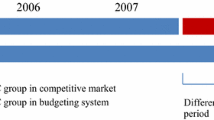Abstract
Little is known about how the adoption and diffusion of medical innovation is related to and influenced by market characteristics such as competition. The particular complications that are involved in investigating these relationships in the health care sector may explain the dearth of research. We examine three invasive cardiac services: diagnostic angiography, percutaneous coronary interventions, and coronary artery bypass grafting. We document the relationship between the adoption by hospitals of these three invasive cardiac services and the characteristics of the hospitals, their markets, and the interactions among them, from 1997 to 2014. The results show that the probability of hospitals’ adopting a new cardiac service depends on competition in two distinct ways: (1) hospitals are substantially more likely to adopt an invasive cardiac service if competitor hospitals also adopt new services; and (2) hospitals are less likely to adopt a new service if a larger fraction of the nearby population already has geographic access to the service at a nearby hospital. The first effect is stronger, leading to the net effect that hospitals duplicate rather than expand access to care. In addition, for-profit hospitals are considerably more likely to adopt these cardiac services than are either nonprofit or government-owned hospitals. Nonprofit hospitals in high-penetration, for-profit markets are also more likely to adopt them relative to other nonprofits. These results suggest that factors other than medical need—such as a medical arms race—partially explain technological adoption.

Similar content being viewed by others
Notes
The cloglog transformation of baseline hazard h is − ln[ln(1 − h)], whereas the logit transformation is the log odds ln[(h)/(1 − h)]. If we add a coefficient c to the transformed hazard to get y = c − ln[ln(1 − h)], we retransform via 1 − exp[− exp(y)] for the new estimated hazard.
These are large changes in market structure, but not infeasible, as such large changes are observed in only 1–5% of cases in our data, but a typical positive adoption rate is 20% (median for diagnostic angiography, with a 30% mean; 13% median and 19% mean for PCI; and 9% median and 15% mean for CABG).
Compared to nonprofit hospitals, for profit hospitals are less likely to adopt CABG if their competitors do (column 8; fp*adoption rate of competitors-CABG), but this is no longer statistically significant after adjusting for being in a for-profit market (column 9).
References
Aghion, P., Bechtold S., Cassar, L., & Herz, H. (2014). The causal effects of competition on innovation: Experimental evidence. NBER Working Paper 19987.
Auerbach, D., Maeda, J. L., & Steiner, C. (2012). Hospital stays with cardiac stents, 2009. HCUP Statistical Brief #128. Retrieved February 14, 2017, from http://www.hcup-us.ahrq.gov/reports/statbriefs/sb128.pdf.
Bates, E. R., & Jacobs, A. K. (2013). Time to treatment in patients with STEMI. New England Journal of Medicine, 369(10), 889–892.
Boden, W. E. (2012). Mounting evidence for lack of PCI benefit in stable ischemic heart disease: What more will it take to turn the tide of treatment? Archives of Internal Medicine, 172(4), 319–321.
Boersma, E., Maas, A. C. P., Deckers, J. W., & Simoons, M. L. (1996). Early thrombolytic treatment in acute myocardial infarction: Reappraisal of the golden hour. The Lancet, 348(9030), 771–775.
Bradley, E. H., Curry, L. A., Webster, T. R., Mattera, J. A., Roumanis, S. A., Radford, M. J., et al. (2006). Achieving rapid door-to-balloon times: How top hospitals improve complex clinical systems. Circulation, 113(8), 1079–1085.
Center for Evaluative Clinical Sciences. (2005). The Dartmouth Atlas of healthcare: Studies of surgical variation. Cardiac surgery report.
Center for Medicare & Medicaid Services. (July, 2015). Health disparities in the medicare population. https://www.cms.gov/About-CMS/Agency-Information/OMH/Downloads/OMH_Dwnld-DataSnashot-Ischemic-Heart-Disease_Final_082015-508.pdf.
Chandra, A., & Skinner, J. S. (2012). Technology growth and expenditure growth in health care. Journal of Economic Literature, 50(3), 645–680.
Chen, J., Krumholz, H. M., Wang, Y., Curtis, J. P., Rathore, S. S., Ross, J. S., et al. (2010). Differences in patient survival after acute myocardial infarction by hospital capability of performing percutaneous coronary intervention. Archives of Internal Medicine, 170(5), 433–439.
Concannon, T. W., Nelson, J., Goetz, J., & Griffith, J. L. (2012). A percutaneous coronary intervention lab in every hospital? Circulation: Cardiovascular Quality and Outcome, 5(1), 14–20.
Cutler, D. M. (2004). Your money or your life. New York: Oxford University Press.
Cutler, D. M., & Kadiyala, S. (2003). The return to biomedical research: Treatment and behavioral effects. In K. M. Murphy & R. H. Topel (Eds.), Measuring the gains from medical research: An economic approach (pp. 110–162). Chicago: The University of Chicago Press.
Cutler, D. M., & McClellan, M. (2001). Is technological change in medicine worth it? Health Affairs, 20(5), 11–29.
Doyle, J. J., Graves, J., Gruber, J., & Kleiner, S. (2015). Measuring returns to hospital care: Evidence from ambulance referral patterns. Journal of Political Economy, 123(1), 170–214.
Eisler, P., & Hansen, B. (2013). Doctors perform thousands of unnecessary surgeries. USA Today. Retrieved February 14, 2017, from http://www.usatoday.com/story/news/nation/2013/06/18/unnecessary-surgery-usa-today-investigation/2435009/.
Epstein, A. J., Polsky, D., Yang, F., Yang, L., & Groeneveld, P. W. (2011). Coronary revascularization trends in the United States, 2001–2008. Journal of the American Medical Association, 305(17), 1769–1776.
Finks, J. F., Osbourne, N. H., & Birkmeyer, J. D. (2011). Trends in hospital volume and operative mortality for high-risk surgery. New England Journal of Medicine, 364(22), 2128–2137.
Flynn, A., Moscucci, M., Share, D., Smith, D., LaLonde, T., Changezi, H., et al. (2010). Trends in door-to-balloon time and mortality in patients with ST-elevation myocardial infarction undergoing primary percutaneous coronary intervention. Archive Internal Medicine, 170(20), 1842–1849.
Heidenreich, P. A., Trogdon, J. G., Khavjou, O. A., Butler, J., Dracup, K., Ezekowitz, M. D., et al. (2011). Forecasting the future of cardiovascular disease in the United States: A policy statement from the American Heart Association. Circulation, 123(8), 933–944.
Heron, M., & Anderson, R. N. (2016). Changes in the leading cause of death: Recent patterns in heart disease and cancer mortality. NCHS Data Brief No. 254. Retrieved February 14, 2017, from https://www.cdc.gov/nchs/data/databriefs/db254.pdf.
Hillman, B. D., Neu, C. R., Winkler, J. D., Aroesty, J., Rettig, R. A., & Williams, A. P. (1987). The diffusion of magnetic resonance imaging scanners in a changing U.S. health care environment. International Journal of Technology Assessment in Health Care, 3(4), 545–559.
Ho, V. (2002). Learning and the evolution of medical technologies: The diffusion of coronary angioplasty. Journal of Health Economics, 21(5), 873–885.
Horwitz, J. R. (2005). Making profits and providing care: Comparing nonprofit, for-profit, and government hospitals. Health Affairs, 24(3), 790–801.
Horwitz, J. R., & Nichols, A. (2009). Hospital ownership and medical services: Market mix, spillover effects, and nonprofit objectives. Journal of Health Economics, 28, 924–937.
Horwitz, J. R., Nichols, A., Nallamothu, B. K., Sasson, C., & Iwashyna, T. J. (2013). Expansion of invasive cardiac services in the United States. Circulation, 128(8), 803–810.
Howard, D. H., & Shen, Y. (2014). Trends in PCI volume after negative results from the COURAGE trial. Health Services Research, 49(1), 153–170.
Jacobson, G., Casillas, G., Damico, A., Neuman, T. & Gold, M. (2016). Medicare advantage 2016 spotlight: Enrollment market update. Retrieved February 14, 2017, from http://files.kff.org/attachment/Issue-Brief-Medicare-Advantage-2016-Spotlight-Enrollment-Market-Update.
Kessler, D. P., & McClellan, M. B. (2000). Is hospital competition socially wasteful? The Quarterly Journal of Economics, 115(2), 577–615.
Ladapo, J. A., Horwitz, J. R., Weinstein, M. C., Gazelle, G. S., & Cutler, D. M. (2009). Adoption and spread of new imaging technology: A case study. Health Affairs, 28(6), w1122–w1132.
Lange, R. A., & Hillis, L. D. (2003). Diagnostic cardiac catheterization. Circulation, 107, e111–e113.
Levine, G. N., Bates, E. R., Blankenship, J. C., Bailey, S. R., Bittl, J. A., Cercek, B., et al. (2011). 2011 ACCF/AHA/SCAI guideline for percutaneous coronary intervention. Circulation, 124, e547–e651.
Matlock, D. D., Groeneveld, P. W., Sidney, S., Shetterly, S., Goodrich, G., Glenn, K., et al. (2013). Geographic variation in cardiovascular procedures: Medicare fee-for-service vs. medicare advantage beneficiaries. Journal of the American Medical Association, 310(2), 155–161. https://doi.org/10.1001/jama.2013.7837.
Menees, D. S., Peterson, E. D., Wang, Y. W., Curtis, J. P., Messenger, J. C., Rumsfeld, J. S., et al. (2013). Door-to-balloon time and mortality among patients undergoing primary PCI. New England Journal of Medicine, 369(10), 901–909.
Nallamothu, B. K., Bates, E. R., Wang, Y., Bradley, E. H., & Krumholz, H. M. (2006). Driving times and distances to hospitals with percutaneous coronary intervention in the United States. Circulation, 113(9), 1189–1195.
Oster, E. (2017). Unobservable selection and coefficient stability: Theory and validation. Journal of Business Economics and Statistics. https://doi.org/10.1080/07350015.2016.1227711. in press.
Robinson, J., & Luft, H. (1985). The impact of hospital market structure on patient volume, average length of stay, and the cost of care. Journal of Health Economics, 4(4), 333–356.
Ross, J. S., Normand, S. T., Wang, Y., Ko, D. T., Chen, J., Drye, E. E., et al. (2010). Hospital volume and 30-day mortality for three common medical conditions. New England Journal of Medicine, 362(12), 1110–1118.
Santerre, R. E., & Adams, A. S. (2002). The effect of competition on reserve capacity: The case of California hospitals in the late 1990s. International Journal of Healthcare Finance and Economics, 2(3), 205–218.
Shapiro, C. (2012). Competition and innovation: Did Arrow hit the bull’s eye? In J. Lerner & S. Stern (Eds.), The rate & direction of inventive activity revisited (pp. 361–410). Chicago: The University of Chicago Press.
Skinner, J. S., & Staiger, D. O. (2015). Technology diffusion and productivity growth in health care. Review of Economics and Statistics, 97(5), 951–964.
Skinner, J. S., Staiger, D. O., & Fisher, E. S. (2006). Is technological change in medicine always worth it? The case of acute myocardial infarction. Health Affairs, 25(2), w34–w47.
Smith, J. C. & Medalia, C. (2015). Health insurance coverage in the United States: 2014, current population reports. Retrieved February 14, 2017, from U.S. Department of Commerce, Economics and Statistics Administration Web site: https://www.census.gov/content/dam/Census/library/publications/2015/demo/p60-253.pdf.
Stergiopoulos, K., Boden, W. E., Hartigan, P., Möbius-Winkler, S., Hambrecht, R., Hueb, W., et al. (2014). Percutaneous coronary intervention outcomes in patients with stable obstructive coronary artery disease and myocardial ischemia: A collaborative meta-analysis of contemporary randomized clinical trials. Archives of Internal Medicine, 174(2), 232–240.
Stergiopoulos, K., & Brown, D. L. (2012). Initial coronary stent implantation with medical therapy vs medical therapy alone for stable coronary artery disease: Meta-analysis of randomized controlled trials. Archives of Internal Medicine, 172(4), 312–319.
Teplensky, J. D., Pauly, M. V., Kimberly, J. R., Hillman, A. L., & Schwartz, J. S. (1995). Hospital adoption of medical technology: An empirical test of alternative models. Health Services Research Journal, 30(3), 437–465.
Torio, C. M., & Moore, B. J. (2016). National inpatient hospital costs: The most expensive conditions by payer, 2013. HCUP Statistical Brief #204. Retrieved February 14, 2017, from https://www.hcup-us.ahrq.gov/reports/statbriefs/sb204-Most-Expensive-Hospital-Conditions.pdf.
Town, R., & Vistnes, G. (2001). Hospital competition in HMO networks. Journal of Health Economics, 20(3), 313–324.
Vrana, D. & White, R. D. (2003). Tenet to settle charges over cardiac care [Electronic version]. L.A. Times. Retrieved February 14, 2017, from http://articles.latimes.com/2003/aug/07/business/fi-settle7.
Weisfeldt, M. L., & Zieman, S. J. (2007). Advances in the prevention and treatment of cardiovascular disease. Health Affairs, 35(12), 25–37.
Wennberg, D. E., Birkmeyer, J. D., & Dartmouth Atlas of Cardiovascular Health Working Group. (1999). The Dartmouth Atlas of Cardiovascular Health Care. Chicago: AHA Press.
Wilson, C. T., Fisher, E. S., Welch, H. G., Siewers, A. E., & Lucas, F. L. (2007). U.S. trends in CABG hospital volume: The effect of adding cardiac surgery programs. Health Affairs, 26(1), 162–168 at 164.
Acknowledgements
The authors thank Stephanie Tomlin, MIHCL, MPA and Weiping Zhou, MS in the Data Analytic Core at The Dartmouth Institute [supported by the National Institute on Aging (PO1-AG19783)] for data support, and Christopher Snyder and an anonymous reviewer for helpful comments. We also thank Jessi Bulaon, Henry Kim, Olivia Metcalfe, Matthew McCabe, Lynn McClelland, Ben Nyblade, and Matthew Parson for research assistance. Horwitz thanks the UCLA School of Law for summer research support.
Funding
Funding was provided by UCLA School of Law.
Author information
Authors and Affiliations
Corresponding author
Rights and permissions
About this article
Cite this article
Horwitz, J.R., Hsuan, C. & Nichols, A. The Role of Hospital and Market Characteristics in Invasive Cardiac Service Diffusion. Rev Ind Organ 53, 81–115 (2018). https://doi.org/10.1007/s11151-018-9625-0
Published:
Issue Date:
DOI: https://doi.org/10.1007/s11151-018-9625-0




